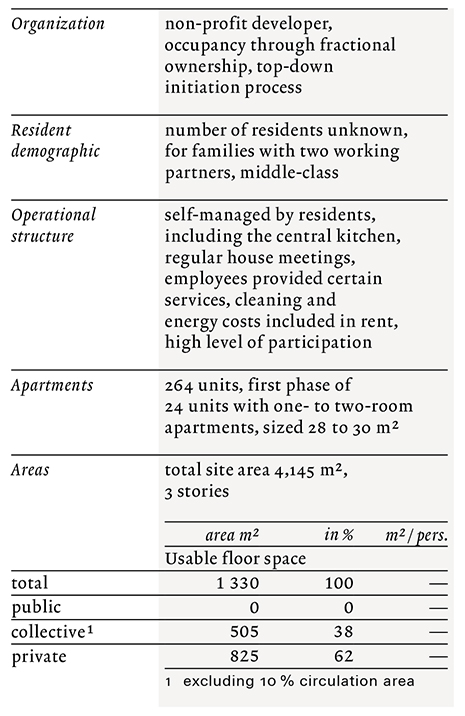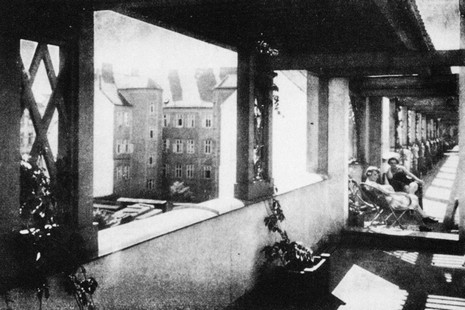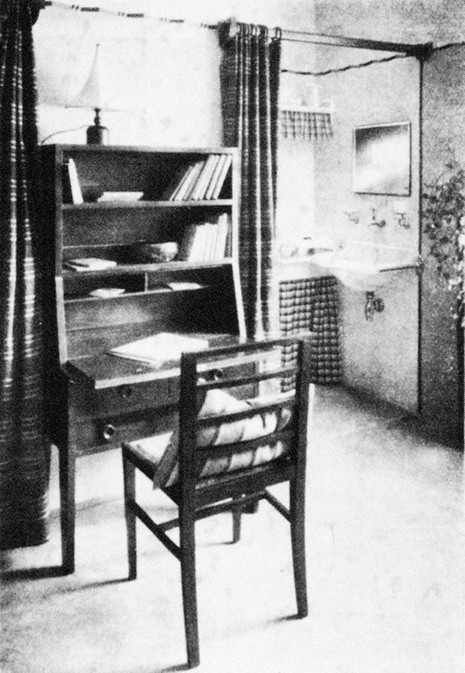Description
Completed in Vienna in 1923, Heimhof was the first Central- Kitchen House to be built by a cooperative housing development organization. Ten years earlier, the Heimhof Construction and Housing Cooperative had built the first central-kitchen boarding house, for single working women, which operated successfully.[1] The new Heimhof Central-Kitchen House aimed to house working families; before moving in, interested parties were required to prove that both partners in the family were employed.[2] Following a design by Otto Polak-Hellwig, the 24 one- and two room apartments built during the first phase lacked kitchens or even an extra room for food preparation; instead, the design included a central kitchen, service lifts, and a main dining room on the ground floor. Unlike the Central-Kitchen Houses in Copenhagen and Berlin, the floor plans and furnishings of the apartments were quite rationalized. The reduction of kitchen and living areas and the introduction of functional niches such as cup-board kitchens and bedroom alcoves meant that, for the first time, the central-kitchen housing model had lost all parallels with the floor plans of bourgeois family apartments.[3] Heimhof also became the first Central-Kitchen House with a dining room for shared meals. This was supplemented by additional shared facilities such as a social area, bathing facility, central launderette, and rooftop terrace. In addition to these collective areas, services such as laundering and cleaning were offered.
Since the Central-Kitchen House was intended to include 264 residential units, the collective areas for the 24 units realized in the first phase were very large. When financial difficulties prevented the housing cooperative from completing construction, the City of Vienna took over and finished the project. In addition to completion of the remaining residential units, a kindergarten was also added in the courtyard. The cooperative retained management of Heimhof ’s daily operations, enabling the residents to remain active participants; they regularly staged events and held meetings to elect representatives responsible for the administration and management of the central kitchen.[4] The Heimhof Central-Kitchen House remained in operation until World War II, when National Socialists liquidated the cooperative and closed the central kitchen and dining room.[5]
 Selected project data
Selected project data
 Street facade with main entrance
Street facade with main entrance
 View of rooftop terrace
View of rooftop terrace
 Cooking and working area of private dwelling
Cooking and working area of private dwelling
Footnotes
Austrian social reformer and women’s rights advocate Auguste Fickert was a proponent of Central- Kitchen Homes for women, which included a central kitchen and a library. See also Uhlig (1981): Kollektivmodell Einküchenhaus, Wohnreform und Architekturdebatte zwischen Frauenbewegung und Funktionalismus, p. 42.
Aigner (2015): Gemeinschaftliches Wohnen, eine Typologie und ihre Vielfalt, p. 64.
Weigel (1996): Die Einraumwohnung als räumliches Manifest der Moderne, p. 29.
Museum of Design Zurich (ed.) (1986): Das andere Neue Wohnen, Neue Wohn(bau)formen, p. 29.
Uhlig (1981): Kollektivmodell Einküchenhaus, Wohnreform und Architekturdebatte zwischen Frauenbewegung und Funktionalismus, p. 42.
Originally published in: Susanne Schmid, Dietmar Eberle, Margrit Hugentobler (eds.), A History of Collective Living. Forms of Shared Housing, Birkhäuser, 2019. Translation by Word Up!, LLC, edited for Building Types Online.